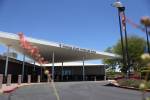Ambulance feud begs bigger question
Somebody call 911.
The escalating feud between the Las Vegas Fire Department and private ambulance business American Medical Response over patient transports has become so bogged down by accusations and counter-claims that the overriding issue in this dispute has practically been forgotten.
Yes, Fire Chief Willie McDonald broke open a barrel of worms when he decided to blow up the city’s dual-response system for emergency calls, relegate AMR to back-bench status and have firefighters take more patients to hospitals. AMR has produced compelling numbers to back up its assertion that the company’s response times — and viability — have been hurt by Fire Department cherry-picking of transports. McDonald, the department and its union have, predictably, attacked the messenger.
But how about backing up to the most basic question of all: Why is a city that spends more than it takes in providing a service that is capably handled by the private sector?
Instead of debating whether McDonald or AMR officials are liars, and which set of numbers is more accurate, let’s discuss why the Fire Department has paramedic units in the first place. Let’s ask why Las Vegas simultaneously provides emergency medical response service at enormous public expense — with firefighters who are paid two to four times what private-sector paramedics earn, in ambulances that cost three times as much as AMR’s modified vans — while collecting hundreds of thousands of dollars in fees from AMR each year for a city franchise.
Instead of making McDonald justify his unilateral assault on AMR, in a government-sanctioned crackdown on a taxpaying business with taxpaying employees, make him explain why the Fire Department should transport any patients to hospitals at all.
Consider that AMR doesn’t receive a dime in direct government subsidies to operate in the valley. Of course, the company receives some tax dollars in exchange for services when it transports Medicaid and Medicare patients, but it collects private insurance reimbursements and cash payments as well. City residents who do not use AMR’s services are under no obligation to pay the company and support its employees. In fact, as mentioned above, AMR pays the city for the opportunity — and risk — of doing business here.
A consultant’s report last year outlined the obvious: the city could save big money if it stopped competing with the private sector for patient transports and limited emergency medical response, perhaps up to $18 million per year. That’s enough to erase the city’s operating budget deficits and create a surplus. The Fire Department could focus on heavy rescue and fires.
But that would have required eliminating firefighter jobs. So the city latched onto the report’s alternative course: muscling out the private sector to grab up to $14 million in new ambulance reimbursement revenue. The Fire Department doesn’t have anywhere near the equipment or the manpower to handle all city patient transports by itself, but that hasn’t stopped McDonald from rushing forward. The firefighters union is fully behind him, too.
City leadership, meanwhile, has been shockingly quiet throughout this process. How, exactly, did McDonald gain the authority to radically change AMR’s franchise, reducing its business and its role to secondary responder? Does this new system, under which AMR ambulances sometimes aren’t dispatched to emergency calls despite being closer to the call than a fire station, have the blessing of the City Council? Considering emergency response suddenly is a citywide issue, where, exactly, is Mayor Carolyn Goodman?
And who will be held accountable when this experiment goes sideways and blows up the budget?
To the city, it goes without saying that patient transportation is a function of local government that must be preserved at all costs — even if it wipes out a company in the process.
The performance of both AMR and Fire Department paramedics isn’t the issue. It’s about business. And government isn’t a business. It has no business competing with one.
Glenn Cook (gcook@reviewjournal.com) is the Las Vegas Review-Journal’s senior editorial writer. Follow him on Twitter: @Glenn_CookNV. Listen to him Mondays at 4 p.m. on “Live and Local with Kevin Wall” on KXNT News Radio, 100.5 FM, 840 AM.
















